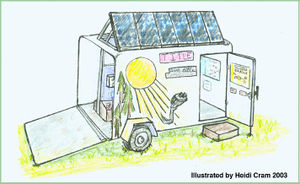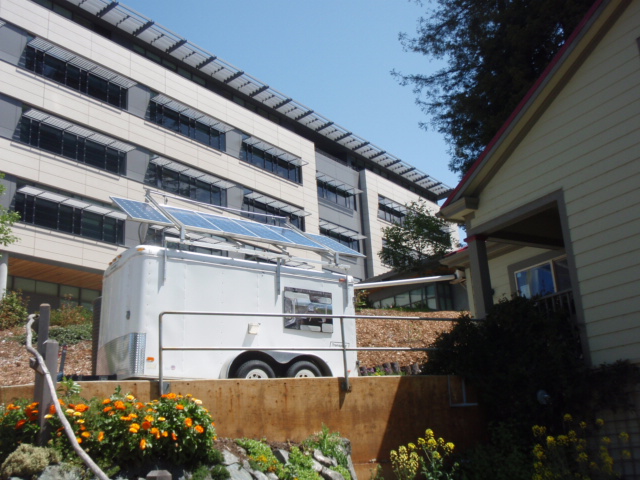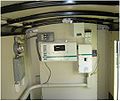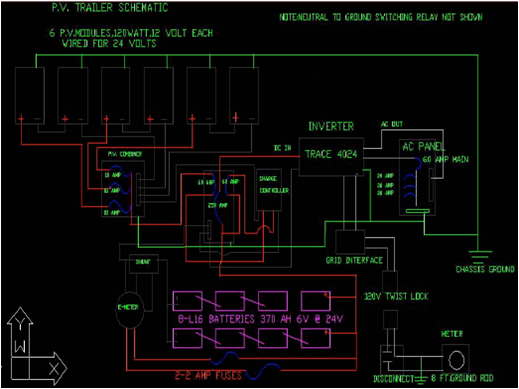Lizkimbrough (talk | contribs) (First draft of MEOW page, needs technical details) |
Sophivorus (talk | contribs) m (Text replacement - "{{CCATpage}}" to "{{CCAT notice}}") |
||
| (18 intermediate revisions by 8 users not shown) | |||
| Line 1: | Line 1: | ||
{{ | {{TOC|right}} | ||
'''MEOW: Mobile Energy Operations Wagon''' | |||
[[File:MEOWatCCAT.jpg]] | |||
= Introduction = | == Introduction == | ||
The Mobile Energy Operations Wagon at the Campus Center for Appropriate Technology, aka: The CCAT's MEOW, is a mobile renewable energy system designed to power local university and community events by showcasing solar-electric technology for interpretive purposes | |||
The Campus Center for Appropriate Technology | |||
The CCAT's MEOW | |||
Cal Poly Humboldt Students involved with the Appropriate Technology course and The Campus Center for Appropriate Technology designed and built the Mobile Renewable Energy Trailer in 2003, which was later named the Mobile Energy Operating Wagon (MEOW). | |||
= Background | == Background == | ||
[[File:CCATMEOW Illustration.jpg|thumb|center|]] | |||
[http://www. | [http://www.humboldt.edu/ Cal Poly Humboldt ]students involved with the Appropriate Technology course and The Campus Center for Appropriate Technology designed and built the Mobile Renewable Energy Trailer in 2003, which was later named the Mobile Energy Operating Wagon (MEOW). | ||
The original proposal (submitted in 2003)contains useful information on the vision of the project, the budget, the energy system schematic, and a detailed list of materials used. | |||
Additional work has been documented for: | |||
This system | * The [[CCAT MEOW rack]] in 2005. | ||
* [[CCAT Mobile Energy Operations Wagon (MEOW) energy analysis|System refurbishment and energy analysis]] in 2010. This page quantified the system's embedded energy and estimated the energy return on investment (EROI). | |||
* [[CCAT Mobile Energy Operations Wagon (MEOW) V2]] in 2012. This page documents the new PV system that was built after the first MEOW was stolen in December 2010. | |||
== | == System components == | ||
<center> | |||
<gallery> | |||
Image:CCAT MEOW ap120.png|Fig. 1 This system has four Astropower AP 120 Panels, rated at 120W each and 2 Sharp 123W panels. | |||
Image:CCAT MEOW inverter.png| Fig. 2 Trace 4024 Inverter | |||
Image:CCAT MEOW hardware.jpg| Fig. 3 Hardware and Conduit | |||
Image:CCAT MEOW batteries.jpg|Fig. 4 Eight lead acid batteries Model L-16from the Trojan Battery Company | |||
Image:CCAT MEOW Haulmark.png|Fig. 5 Haulmark Cub 6' (dual axle) Trailer | |||
Image:CCATMEOWinternalwiring1.jpg| Fig. 6 Internal view from 2005 | |||
</gallery></center> | |||
== | == Schematic == | ||
[[File:CCAT MEOW schematic Scurfield.png]] | |||
{{CCAT notice}} | |||
{{Page data}} | |||
[[Category:CCAT|M]] | |||
Latest revision as of 12:53, 6 February 2023
MEOW: Mobile Energy Operations Wagon
Introduction[edit | edit source]
The Mobile Energy Operations Wagon at the Campus Center for Appropriate Technology, aka: The CCAT's MEOW, is a mobile renewable energy system designed to power local university and community events by showcasing solar-electric technology for interpretive purposes
Cal Poly Humboldt Students involved with the Appropriate Technology course and The Campus Center for Appropriate Technology designed and built the Mobile Renewable Energy Trailer in 2003, which was later named the Mobile Energy Operating Wagon (MEOW).
Background[edit | edit source]

Cal Poly Humboldt students involved with the Appropriate Technology course and The Campus Center for Appropriate Technology designed and built the Mobile Renewable Energy Trailer in 2003, which was later named the Mobile Energy Operating Wagon (MEOW).
The original proposal (submitted in 2003)contains useful information on the vision of the project, the budget, the energy system schematic, and a detailed list of materials used.
Additional work has been documented for:
- The CCAT MEOW rack in 2005.
- System refurbishment and energy analysis in 2010. This page quantified the system's embedded energy and estimated the energy return on investment (EROI).
- CCAT Mobile Energy Operations Wagon (MEOW) V2 in 2012. This page documents the new PV system that was built after the first MEOW was stolen in December 2010.
System components[edit | edit source]
-
Fig. 1 This system has four Astropower AP 120 Panels, rated at 120W each and 2 Sharp 123W panels.
-
Fig. 2 Trace 4024 Inverter
-
Fig. 3 Hardware and Conduit
-
Fig. 4 Eight lead acid batteries Model L-16from the Trojan Battery Company
-
Fig. 5 Haulmark Cub 6' (dual axle) Trailer
-
Fig. 6 Internal view from 2005







